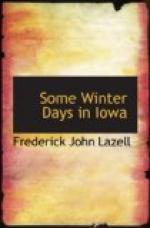* * * * *
The snow is winter’s great gift to states like Iowa. He is unwise who complains of the tender, protecting, nourishing, fructifying mantle of immaculate white. Where the snow lies deepest in winter, there shall you find the greatest flush of new life in the spring. Down under the snow Nature’s chemical laboratory is at work. Take a stick and dig under the thick white blanket into the black soil. Here are bulbs and buds, corms and tubers, rootstalks and rhizomes, which were pumped full of starch and albumen in the hot days of last August. So far as modern science is able to tell, chemical changes are in constant progress in all these forms of underground life, preparing for the coming glory of the living green. Nature never dies. She scarcely sleeps.
Tracks on the all-revealing snow tell of an equal abundance of animal life. These rabbit tracks, scarcely two feet apart, tell how happily bunny was going. But farther on a dog came across at an angle and gave chase. The tracks are now farther apart, three feet, four feet, as up bunny goes to his burrow under the shelving rock. One last bound, nearly five feet, and he was safe. That was once when “heaven was gained at a single bound.”
Bunny was too far away from home that time. Here is his usual runway from the burrow to the brook, and the nibbled barks of the saplings tell of a tender breakfast before he went prospecting. Rabbits usually run in beaten paths.




